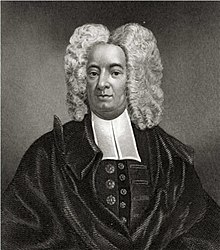Welcome to DU!
The truly grassroots left-of-center political community where regular people, not algorithms, drive the discussions and set the standards.
Join the community:
Create a free account
Support DU (and get rid of ads!):
Become a Star Member
Latest Breaking News
General Discussion
The DU Lounge
All Forums
Issue Forums
Culture Forums
Alliance Forums
Region Forums
Support Forums
Help & Search
History of Feminism
Showing Original Post only (View all)Cotton Mather ~ Spectral Evidence [View all]

Spectral evidence is a form of evidence based upon dreams and visions. It was admitted in court during the Salem witch trials by the appointed chief justice, William Stoughton. The booklet A Tryal of Witches taken from a contemporary report of the proceedings of the Bury St. Edmunds witch trial of 1662 became a model for, and was referenced in the Trials when the magistrates were looking for proof that such evidence could be used in a court of law.
Spectral evidence was testimony that the accused witch's spirit (i.e. spectre) appeared to the witness in a dream or vision (for example, a black cat or wolf). The dream or vision was admitted as evidence. Thus, witnesses (who were often the accusers) would testify that "Goody Proctor bit, pinched, and almost choked me," and it would be taken as evidence that the accused were responsible for the biting, pinching and choking even though they were elsewhere at the time.
http://en.wikipedia.org/wiki/Spectral_evidence
Martha Carrier
Calling her a "rampant hag" and the "Queen of Hell," the Reverend Cotton Mather harbored no doubts that Martha Carrier deserved to be executed as a witch during the Salem outbreak on August 19, 1692. The Salem documents themselves, however, reveal that her crime was not witchcraft but an independence of mind and an unsubmissive character. A daughter of one of the founding families of Andover, Martha married a young Welsh servant, Thomas Carrier, in 1674, by whom she had four children. The Salem accusation against Martha came only two years after the selectmen of Andover blamed a smallpox epidemic on her witchcraft. Although historians have blamed her accusation on causes ranging from a conspiracy against Andover's proprietary families to reaction against threats to patriarchal inheritance, her contentious spirit and the earlier charge of witchcraft seem the most plausible explanation.
Calling her a "rampant hag" and the "Queen of Hell," the Reverend Cotton Mather harbored no doubts that Martha Carrier deserved to be executed as a witch during the Salem outbreak on August 19, 1692. The Salem documents themselves, however, reveal that her crime was not witchcraft but an independence of mind and an unsubmissive character. A daughter of one of the founding families of Andover, Martha married a young Welsh servant, Thomas Carrier, in 1674, by whom she had four children. The Salem accusation against Martha came only two years after the selectmen of Andover blamed a smallpox epidemic on her witchcraft. Although historians have blamed her accusation on causes ranging from a conspiracy against Andover's proprietary families to reaction against threats to patriarchal inheritance, her contentious spirit and the earlier charge of witchcraft seem the most plausible explanation.
Carrier's reputation as a witch found new expression two years later when the outbreak in Salem began. As the testimony of the circle of accusing girls reflected, the Salem community was well aware of Andover's gossip. Susan Sheldon, Mary Walcot, Elizabeth Hubbard and Ann Putnam screamed before the court that they could see the 13 ghosts of Andover. Other neighbors accused her of maleficium, testifying that after harsh words from her, evil things like sick or dead animals or strange illnesses befell them. During her courtroom examination, however, Carrier stood her ground and boldly asserted that those who accused her lied. Asked if she could then look upon the girls, seemingly possessed, without their writhing in pain, she said she would not, for "they will dissemble if I look upon them." Later, she admonished the magistrates, saying "it is a shamefull thing that you should mind these folks that are out of their wits."
http://www2.iath.virginia.edu/saxon-salem/servlet/SaxonServlet?source=salem/texts/bios.xml&style=salem/xsl/dynaxml.xsl&chunk.id=b4&clear-stylesheet-cache=yes
I find the group think in all of this, so interesting, and others turning on friends and family to save themselves from the real evil.
InfoView thread info, including edit history
TrashPut this thread in your Trash Can (My DU » Trash Can)
BookmarkAdd this thread to your Bookmarks (My DU » Bookmarks)
14 replies, 6553 views
ShareGet links to this post and/or share on social media
AlertAlert this post for a rule violation
PowersThere are no powers you can use on this post
EditCannot edit other people's posts
ReplyReply to this post
EditCannot edit other people's posts
Rec (8)
ReplyReply to this post
14 replies
 = new reply since forum marked as read
Highlight:
NoneDon't highlight anything
5 newestHighlight 5 most recent replies
= new reply since forum marked as read
Highlight:
NoneDon't highlight anything
5 newestHighlight 5 most recent replies
and people protect what has been established and what is comfortable at all costs
seabeyond
Jul 2012
#9